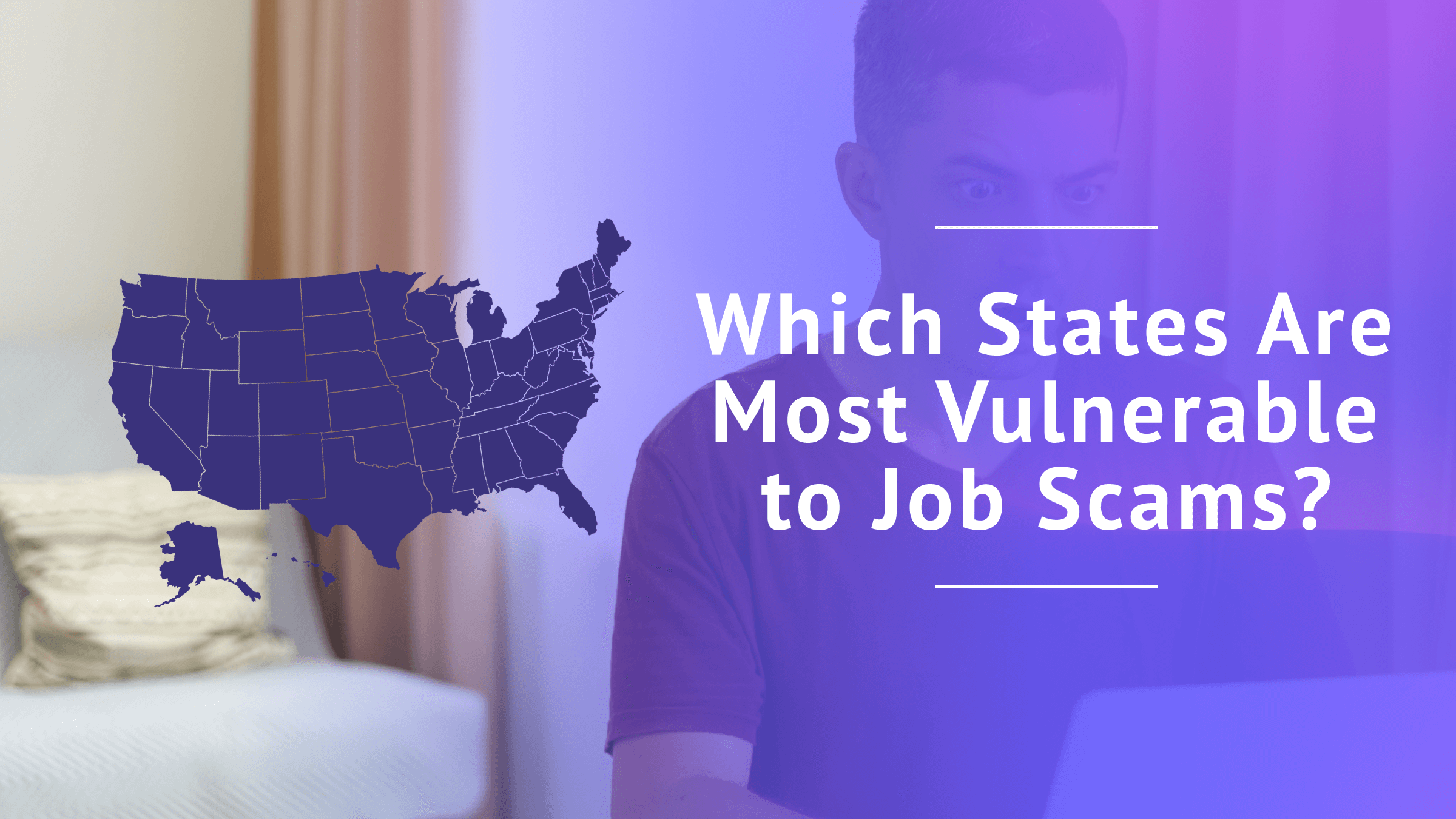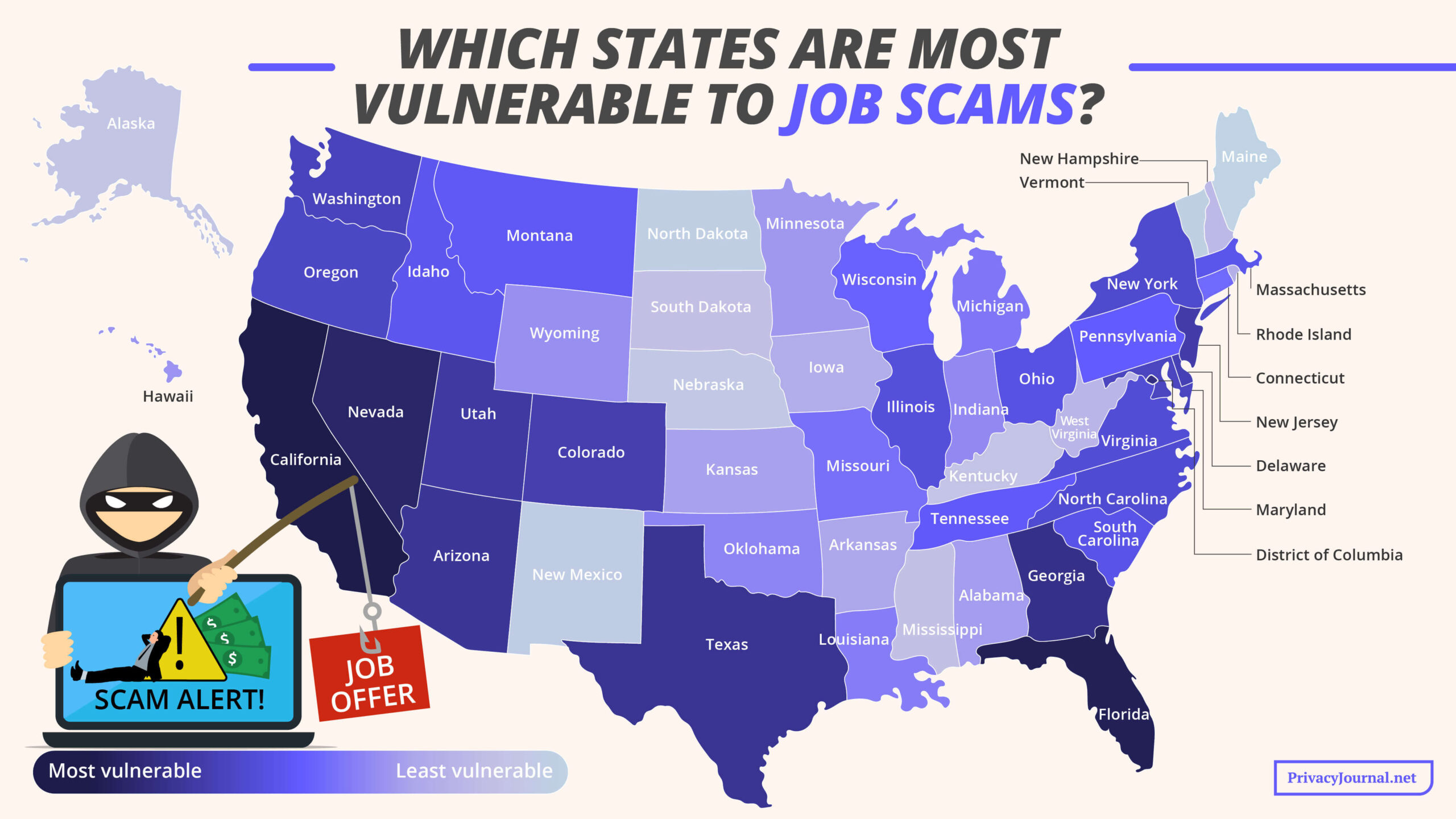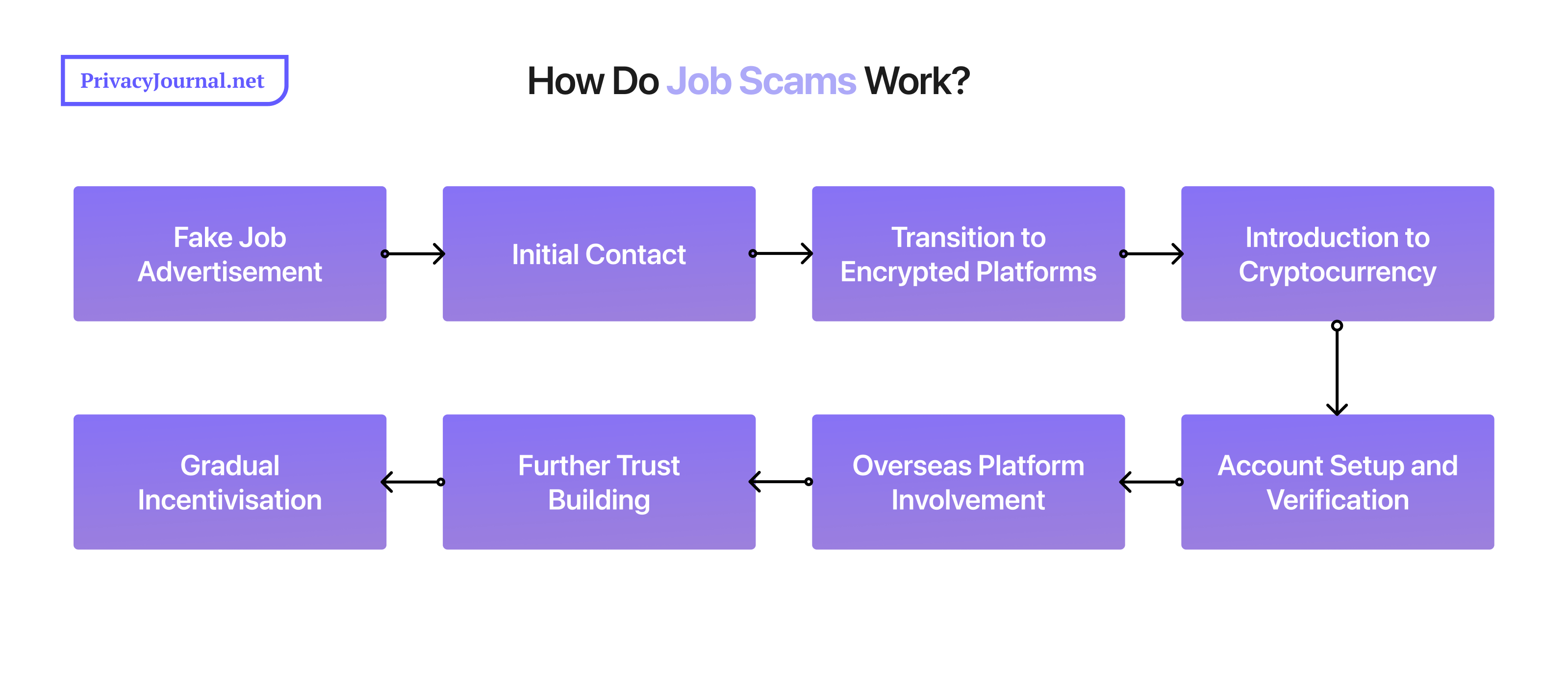
Which States Are Most Vulnerable to Job Scams?
- Table of Contents
- States Most Vulnerable to Job Scams
- Key Findings: Job Scams in the U.S. Over Time
- State Rankings: American Job Scam Risks
- U.S. States With the Highest Job Scam Risk
- Best U.S. States for Job Seekers
- Job Scam Report Growth Rates & Financial Loss Percentage Changes
- How Do Job Scams Work?
- How to Identify Employment Scams
- Methodology & Sources
- Conclusion
- FAQ: Fake Jobs
Quick Answer: California is the most vulnerable to job scams, followed closely by Florida and Nevada. Maine is the least at risk, along with Vermont and North Dakota.
The Federal Trade Commission (FTC) released its 2024 data book, revealing that business and job opportunity scams caused a reported loss of $751 million. Job scamming is the third most reported type of fraud, after imposter scams and online shopping scams, according to online scam statistics. For this reason, we decided to take a closer look at job scams to better understand their effects on unemployed individuals.
To raise awareness, PrivacyJournal gathered and analyzed the 2024 data on job scam reports, financial losses caused by job scams, job scam report growth rates (2022-2024), percentage changes in total financial losses (2022-2024) and unemployment rates. Based on this information, our research team ranked the states from most to least susceptible to job scams.
I hope that these results will not only make for informative reading but also help prevent the devastating impact of fraudulent work proposals on job seekers.
- Note: Our research team included Washington, D.C. within the state rankings.
States Most Vulnerable to Job Scams

Key Findings: Job Scams in the U.S. Over Time
- Vulnerable high-population states: California tops the ranking as the state most vulnerable to job scams. Florida, another populous state, is in second place, and Georgia and Texas are also in the top 10.
- Rural states at lower risk: Maine and Vermont are two states with a high percentage of rural areas, and they rank 51st and 50th, respectively. Other states with high rural populations — including Mississippi, South Dakota, New Hampshire and Kentucky — are also in the bottom 10.
- Trends in growth rates: Though Montana ranks in the middle, it showed the highest growth rate of job scam reports per million people between 2022 and 2024. There’s a clear regional connection here, as neighboring Idaho placed third in the growth rate category.
- Biggest financial losses: California, Florida and Texas were hit the hardest by monetary losses caused by job scams. Taking the top spot, California’s losses amount to over $81.8 million in 2024.
- Financial loss percentage changes: Despite ranking among the least vulnerable states overall, North Dakota, South Dakota and Nebraska displayed the highest percentage changes in total dollar losses from 2022 to 2024.
- Unemployment rate disparity: States with the highest unemployment rates (Nevada, California and Washington, D.C.) ranked at the top. However, some states with low or moderate unemployment rates, such as Utah and Maryland, fell within the top 15 overall.
State Rankings: American Job Scam Risks
The first table shows how we ranked U.S. states in terms of job scam vulnerability, with one representing the most vulnerable and 51 representing the least vulnerable.
The second table shows the actual figures representing the number of job scam reports per million people, as well as the total financial losses related to job scams per state. It also displays the growth rate of job scam reports (2022-2024), the percentage change in total financial losses over the same period, and the state unemployment rates.
Ranking U.S. States’ Vulnerability to Job Scams
| Ranking | State | Final Weighted Score | Job Scam Reports per Million People | Job Scam Loss ($) per State | Growth Rate of Reports per Million People (2022-2024) | Percentage Change in Total $ Loss (2022-2024) | Unemployment Rate by State |
|---|---|---|---|---|---|---|---|
| 1 | California | 65.789 | 12 | 1 | 24 | 23 | 2 |
| 2 | Florida | 65.225 | 3 | 2 | 6 | 26 | 31 |
| 3 | Nevada | 60.280 | 1 | 20 | 10 | 11 | 1 |
| 4 | District of Columbia (D.C.) | 57.126 | 2 | 38 | 15 | 12 | 3 |
| 5 | Georgia | 51.759 | 4 | 6 | 13 | 9 | 29 |
| 6 | Texas | 50.652 | 11 | 3 | 29 | 28 | 17 |
| 7 | Arizona | 48.095 | 6 | 8 | 16 | 16 | 25 |
| 8 | Utah | 47.005 | 5 | 17 | 7 | 14 | 34 |
| 9 | New Jersey | 44.267 | 13 | 5 | 14 | 8 | 8 |
| 10 | Colorado | 43.539 | 7 | 14 | 21 | 33 | 11 |
| 11 | Delaware | 43.092 | 9 | 39 | 2 | 39 | 22 |
| 12 | Washington | 41.514 | 15 | 7 | 11 | 6 | 8 |
| 13 | Maryland | 39.479 | 8 | 10 | 42 | 32 | 40 |
| 14 | Oregon | 38.802 | 16 | 21 | 4 | 17 | 15 |
| 15 | New York | 37.591 | 17 | 4 | 41 | 25 | 11 |
| 16 | North Carolina | 37.121 | 14 | 12 | 17 | 27 | 25 |
| 17 | Virginia | 36.908 | 10 | 11 | 22 | 40 | 46 |
| 18 | Illinois | 34.736 | 18 | 9 | 20 | 31 | 5 |
| 19 | Ohio | 29.734 | 26 | 15 | 19 | 7 | 11 |
| 20 | South Carolina | 29.492 | 19 | 18 | 26 | 30 | 17 |
| 21 | Massachusetts | 27.965 | 28 | 16 | 12 | 35 | 21 |
| 22 | Idaho | 27.923 | 27 | 35 | 3 | 43 | 22 |
| 23 | Montana | 27.601 | 30 | 49 | 1 | 44 | 40 |
| 24 | Tennessee | 26.073 | 20 | 19 | 32 | 42 | 31 |
| 25 | Pennsylvania | 24.907 | 21 | 13 | 40 | 36 | 25 |
| 26 | Wisconsin | 24.647 | 44 | 28 | 5 | 20 | 40 |
| 27 | Connecticut | 23.970 | 23 | 27 | 36 | 13 | 34 |
| 28 | Missouri | 23.777 | 22 | 24 | 33 | 29 | 22 |
| 29 | Michigan | 23.700 | 25 | 23 | 31 | 46 | 6 |
| 30 | Louisiana | 23.044 | 34 | 26 | 39 | 5 | 10 |
| 31 | Oklahoma | 22.57 | 32 | 29 | 25 | 22 | 33 |
| 32 | Indiana | 22.388 | 39 | 22 | 44 | 4 | 15 |
| 33 | Wyoming | 22.125 | 24 | 41 | 37 | 18 | 34 |
| 34 | Hawaii | 21.783 | 43 | 32 | 18 | 15 | 40 |
| 35 | Minnesota | 21.145 | 40 | 25 | 23 | 19 | 40 |
| 36 | Alabama | 20.970 | 29 | 30 | 35 | 34 | 38 |
| 37 | Kansas | 19.742 | 35 | 44 | 27 | 41 | 25 |
| 38 | Arkansas | 19.730 | 31 | 37 | 28 | 45 | 29 |
| 39 | Iowa | 18.784 | 47 | 31 | 8 | 24 | 40 |
| 40 | Rhode Island | 17.498 | 41 | 51 | 30 | 48 | 11 |
| 41 | West Virginia | 17.357 | 42 | 45 | 34 | 37 | 17 |
| 42 | New Hampshire | 17.159 | 37 | 43 | 43 | 21 | 48 |
| 43 | South Dakota | 16.926 | 50 | 46 | 9 | 2 | 51 |
| 44 | Mississippi | 16.381 | 36 | 42 | 38 | 49 | 34 |
| 45 | Kentucky | 15.698 | 45 | 33 | 45 | 47 | 4 |
| 46 | Alaska | 15.611 | 38 | 47 | 47 | 38 | 7 |
| 47 | Nebraska | 13.720 | 46 | 36 | 46 | 3 | 47 |
| 48 | New Mexico | 13.218 | 33 | 34 | 51 | 51 | 17 |
| 49 | North Dakota | 11.155 | 51 | 40 | 50 | 1 | 49 |
| 50 | Vermont | 6.420 | 49 | 48 | 48 | 10 | 50 |
| 51 | Maine | 5.348 | 48 | 50 | 49 | 50 | 38 |
U.S. States With the Highest Job Scam Risk
Now I’ll take a closer look at the states that are ranked most vulnerable to job scams, along with the contributing factors at play.
California — Golden State Hit the Hardest
California has the unwelcome distinction of being the top-ranked state for job scam risks overall. Most notably, it has suffered the steepest financial loss in 2024 — a whopping $81,848,547, to be precise. At 5.3%, the unemployment rate is the second-highest after its neighbor, Nevada. All that said, California’s job scam report and financial loss percentage change rates are moderate.
My take: Given its huge population and range of industries (such as tech, film and banking), possible factors behind California’s high ranking include the state’s large target pool and above-average living costs. Coupled with the high unemployment rate, this situation could make job seekers who are in desperate situations all the more vulnerable to scams.
What’s more, California is the state with the largest immigrant population. Job seekers who don’t speak English as a first language may be even more susceptible to fraud.
Florida — Ranked Second Overall for Job Scam Vulnerability
Coming up just behind California is Florida, a state ranked highly vulnerable in terms of job scam reports, financial loss and report growth rate (2022-2024). Like California, Florida’s vast population and expensive living costs may play a role in its high ranking.
However, at 3.4%, Florida’s unemployment rate is far better than California’s, suggesting that unemployment rates and job scam vulnerability don’t always go hand in hand.
My take: While Florida is one of the states most severely impacted, its moderate financial loss percentage change indicates that the state may be taking steps to reduce the impact of employment scams by raising awareness.
For example, in my research, I came across several Florida websites — from job boards to the Office of the Attorney General — warning readers about job scams and sharing tips on how to avoid being frauded.
Nevada — Sky-High Unemployment Rates
California’s neighboring state and home to the vibrant Las Vegas strip, Nevada is third on our ranking. Behind all the glitz is a state struggling with unemployment (5.6%) and the highest number of job scam reports per million people in the U.S.
My take: People may move to places like Las Vegas hoping to find new and exciting work opportunities, lower living costs and a better quality of life, but scammers can prey on those mindsets. On the flip side, Nevada’s financial loss from job scams is much lower than that of California or Florida.
Best U.S. States for Job Seekers
With all the doom and gloom out of the way, let’s explore the states ranked safest for avoiding job scams.
Maine — Pine Tree State Ranked Least Vulnerable
Rural Maine ranks 51st overall, crowning it as the least risky state in terms of employment scams. It scored low across the board, including report growth rates and financial loss percentage changes, indicating a consistent pattern of lower risk.
My take: The state has one of the smallest populations in the U.S. and a pretty low population density, potentially making it a less appealing target for scammers. Maine also has a relatively low unemployment rate of 3.1%, though this doesn’t always correlate with low risk.
Vermont — Low Risk but High Financial Loss Percentage Change
Vermont, another Northeastern state with a relatively small population, has the second-lowest risk in the ranking. Vermont narrowly surpasses Maine as the most rural U.S. state, and it may share many of the factors that influence Maine’s low level of risk.
My take: Vermont’s performance is impressive across the board, except in one category: percentage change in total financial losses (2022-2024). This is markedly similar to North Dakota, the state with the third-lowest risk overall.
North Dakota — Earmarked for High-Value Scams?
Like Vermont, North Dakota also performs strongly in all categories aside from its high financial loss percentage change. In fact, the state ranked first in this category.
My take: While there may be fewer scams overall in North Dakota than other states, it’s possible that ambitious scammers could be strategically targeting people who are aiming to work in the most lucrative industries. The oil and gas industry has been a known target of investment scammers.
Job Scam Report Growth Rates & Financial Loss Percentage Changes
This section dives into the rate of change from 2022 to 2024 in job scams and financial loss.
States With Increased Rates of Scams and Financial Loss
The growth rate of job scam reports between 2022 and 2024 is highest in Montana (1st), neighboring Idaho (3rd) and Delaware (2nd). Though Delaware ranks 11th overall in our risk ranking, Montana and Idaho rank near the middle at 22nd and 23rd, respectively. This suggests a possible regional connection and indicates that job scams are starting to spread to less-targeted areas.
While we can only speculate on a regional connection, recent local sources from both Montana and Idaho suggest growing concern about job scams. A 2024 report from NBC Montana explains that while jobseekers did not lose an “exorbitant amount of money” that year as a result of job scams, many people handed over “sensitive information.”
In 2024, the Better Business Bureau raised the alarm about “identity fraud scams” orchestrated by Intelligent Post, described as a “fraudulent Idaho-based reshipping company.” The scam targeted job seekers specifically.
States With Lower Rates of Scams and Financial Loss
The states with the lowest job scam report growth rates are New Mexico, North Dakota and Maine, all of which rank at the bottom of our risk ranking.
Interestingly, although California ranked first overall in our risk ranking, it displays only a moderate growth rate at 24th place, which could indicate gradual progress in tackling job scams, possibly by educating people via well-known sources. For example, like in Florida, an abundance of California websites — including those of government agencies, universities and news platforms — highlight the issue of job and business scams.
Despite being one of the least vulnerable states overall, North Dakota ranks first for percentage change in total financial losses (2022-2024). This could hint that job and business scammers are targeting the state’s big industries — like oil and gas — as well as its skilled workers, as I discuss further up.
South Dakota and Nebraska are two more states that ranked low for overall risk but scored high in this category.
How Do Job Scams Work?
Job scams work by getting applicants to respond to a job posting, getting them to provide personal or financial information — for an employment opportunity that doesn’t exist.
Job scammers could have any number of objectives. For example, some aim to extract money, personal details or financial information, while others try to deceive you into working for free.

To these ends, scammers often create fake job postings, though scams can come in various forms. Then, they demand to receive payment or sensitive information like personal bank account details.
Free work scammers may promise to pay you once you complete a task but then fail to do so. Another method is to ghost you after you complete a “trial task” for them. In reality, they were never going to offer you work — they just wanted something done for free.
Job scams may appear on job search websites and social media, and it can be hard to tell whether a posting is real or fake.
How to Identify Employment Scams
As the first rule of thumb, if a job offer seems too good to be true, it probably is. Watch out for the following signs:
- Quickly offering employment without any due procedures, like an actual job application or interview.
- Providing vague wordings in the job offer.
- Offering high pay for minimal work or entry-level experience.
- Asking you to pay for something (such as supplies, certifications or training).
- Requesting personal details like your bank account information, ID or social security number.
- Lacking an online presence, such as a professional website or official social media account.
- Displaying unprofessional levels of communication or online presence. For example, a fake company site or job description may be full of spelling and grammatical errors.
- Providing URLs that display “http://” instead of “https://”.
- Communicating through messaging apps like WhatsApp.

scammers offer the world for very little effort on your part.
5 Common Fake Job Listings & Types
As we touched on earlier, job scams come in all shapes and sizes, and there are endless types of fake listings out there. Common job scams include the following:
- Data-entry scams: Work-at-home scams like data-entry scams often promise very easy work for an unrealistically high salary, and require no former experience.
- Easy online tasks: Some scammers promise money in exchange for completing quick and easy tasks online, like leaving a review or commenting on social media posts.
- Pyramid scheme: This type of recruitment scam typically makes victims pay money upfront. The scammer tells the victim that they must recruit others to the scheme to earn a profit.
- Postal service: The victim is offered a “job” working with the postal system, after which they are tricked into paying for fake employment and training programs.
- Messaging apps: Scammers commonly contact potential victims via messaging services like Telegram or WhatsApp while pretending to be a hiring manager.
Where to Report Job Scams
Based on advice from the U.S. Federal Trade Commission, if you have sent a payment or given your bank details to a scammer, the first step is to contact your bank or money transfer service. If you physically handed the money over to them, then you’ll need to contact the police.
U.S. residents who have given their social security number to a scammer can report this via IdentityTheft.gov. In the meantime, you can send job scam reports to ReportFraud.ftc.gov. Those outside the U.S. will need to check the local entities that deal with job fraud in their area.
Methodology & Sources
Our research team analyzed job scam data covering a variety of categories from the FTC and the Bureau of Labor Statistics (BLS). States were assigned weighted points (see the breakdown below) to create an overall ranking showing which states are the most and least vulnerable to job scams.
Data Categories:
- Job scam reports per million people, including:
- Business and work-at-home opportunities
- Job scams and employment agencies
- Pyramids and multi-level marketing
- Job scam loss ($) per state:
- Business and work-at-home opportunities
- Job scams and employment agencies
- Pyramids and multi-level marketing
- Growth rate of reports per million people (2022-2024)
- Percentage change in total financial loss (2022-2024)
- Unemployment rates by state
Weighting Breakdown:
- Job scam reports per million people — 40%
- Job scam loss ($) per state — 30%
- Growth rate of reports per million people (2022-2024) — 15%
- Percentage change in total financial loss (2022-2024) — 10%
- Unemployment rates by state — 5%
Once the results were finalized, I analyzed the data to look for noticeable patterns and further researched why certain states ranked higher than others.
Conclusion
Falling prey to a job scammer can be devastating. The effects can be far-reaching, affecting not only the victim’s professional life but also their personal life.
It’s important to note that while some scammers reveal themselves through blatant unprofessionalism and bizarre pledges, others can be incredibly subtle. You must be vigilant at all times and fully research any companies or individuals you’re considering as employers, especially before providing personal information.
If you’d like to educate yourself more about online scams, read our guides on:
FAQ: Fake Jobs
Are There Job Scams on LinkedIn?
Yes, job scams can be on any social media platform. LinkedIn job scams are often too good to be true, involving job offers promising that you’ll make a fortune with entry-level experience or by completing very simple tasks.How to Spot Scams on Job Boards?
Job board scams are often vague and unprofessional. They may promise extremely high pay for little effort. When you research these “companies,” you’ll often find that they have no credible online presence.Why Are There So Many Job Scams?
It has become increasingly common to use the internet to find work, and there has been a surge in people looking for work-from-home jobs in recent years. This allows scammers to cast a wide net, and hiding behind a screen makes them feel safe.How Can I Protect My Personal Information From Job Scams?
If you doubt whether a company or individual is credible, trust your gut. Thoroughly research the company in question, ask a lot of questions and never give out your personal details upfront.

Leave a Reply